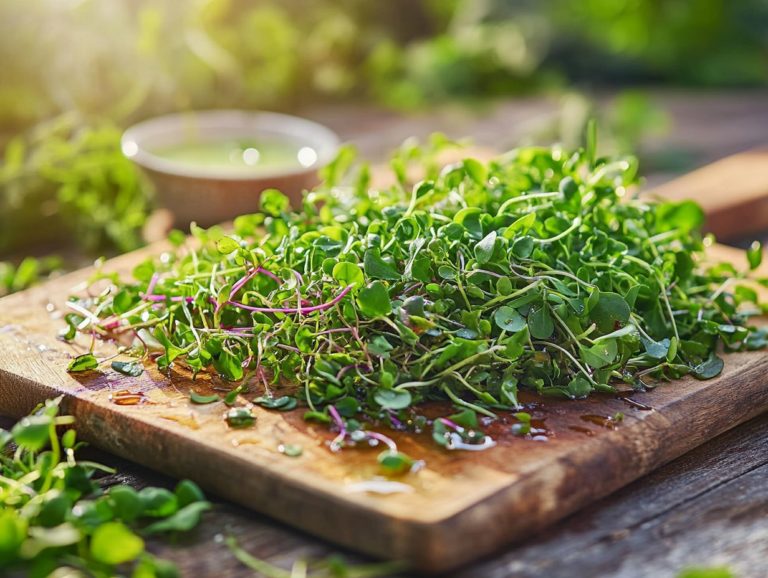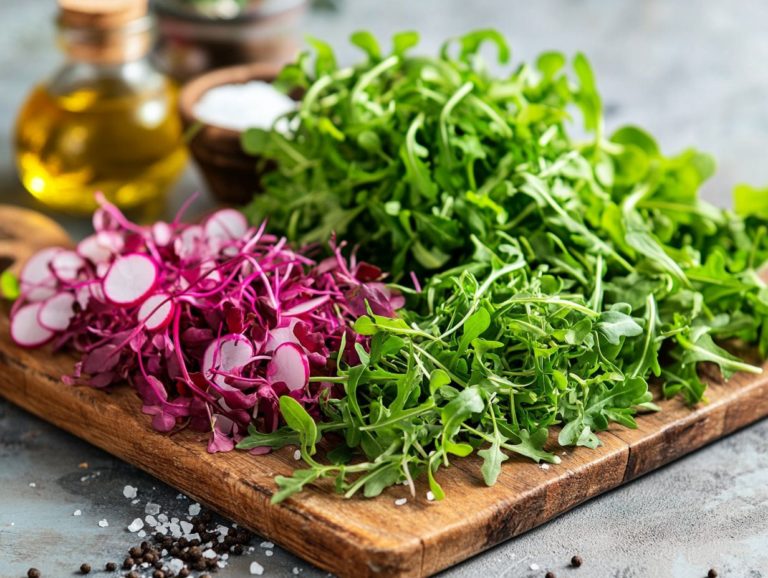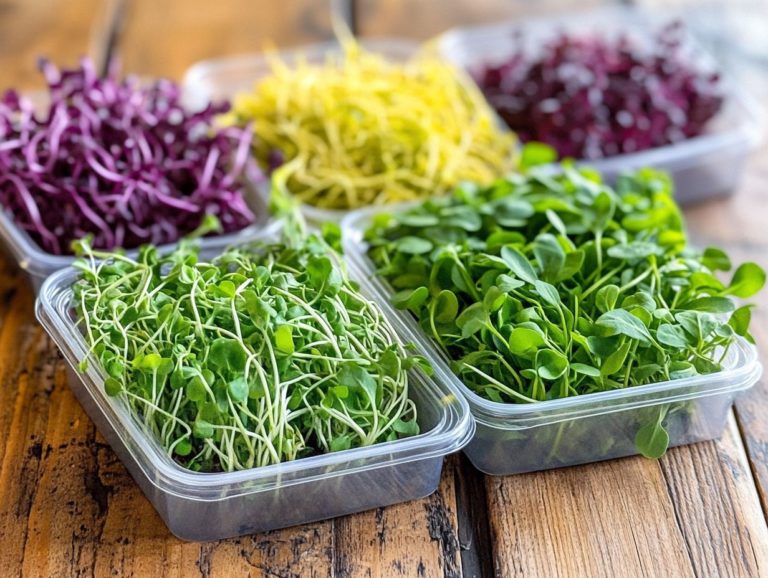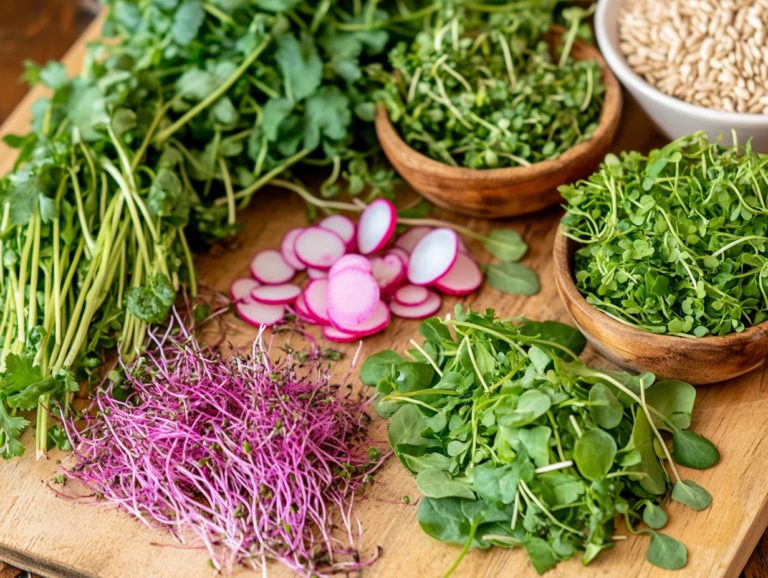Microgreens: A Natural Source of Nutrients
Microgreens are small yet formidable powerhouses of flavor and nutrition, often overlooked in the culinary landscape. These tiny greens offer a concentrated source of vitamins, minerals, and antioxidants that can significantly enhance your meals and overall health.
This article delves into the wonders of microgreens: what they are, their remarkable nutritional benefits, and how they stack up against other leafy greens. You ll uncover how to grow and harvest them at home, learn to incorporate them into your diet, and become aware of any potential risks.
Prepare to immerse yourself in the vibrant world of microgreens and discover how they can make your meals even better!
Contents
- Key Takeaways:
- What are Microgreens?
- Nutritional Benefits of Microgreens
- Growing and Harvesting Microgreens
- Incorporating Microgreens into Your Diet
- Potential Risks and Precautions
- Frequently Asked Questions
- What are microgreens?
- Why are microgreens considered a natural source of nutrients?
- What types of nutrients can be found in microgreens?
- How do microgreens compare to full-grown vegetables in terms of nutrition?
- What are the health benefits of consuming microgreens?
- How can microgreens be incorporated into a diet?
Key Takeaways:
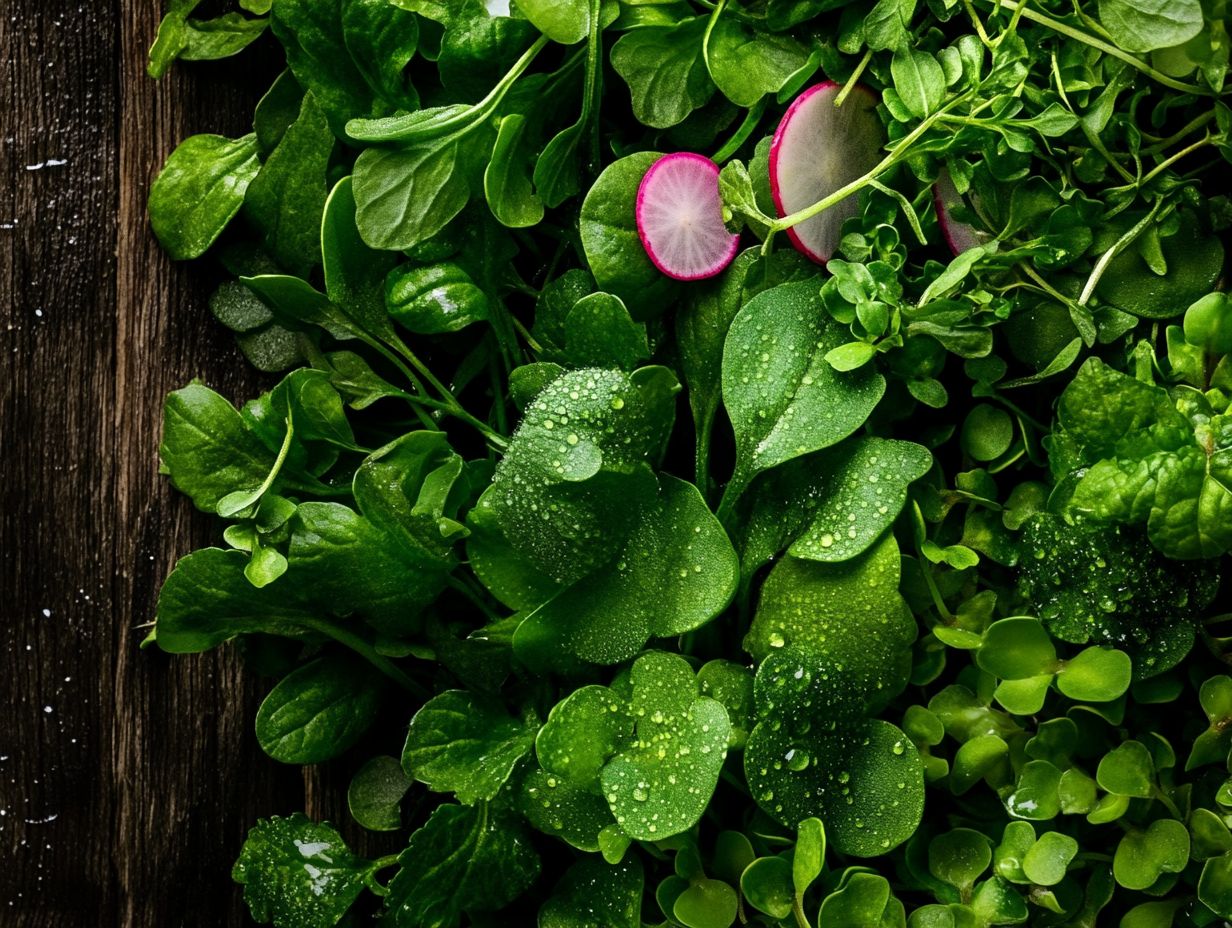
- Microgreens are young, tender greens packed with essential nutrients.
- They contain higher nutrient levels than mature greens.
- With proper techniques, you can easily add them to your meals.
What are Microgreens?
Microgreens are young vegetables harvested at their peak freshness, delivering intense flavors and a wealth of concentrated nutrients an ideal choice for health enthusiasts.
These petite greens are typically gathered within 7 to 21 days post-germination. They not only captivate the eye but also offer many culinary possibilities, from vibrant salads to elegant garnishes.
They originate from various plant families, including the esteemed Brassica family, which features beloved varieties like kale and broccoli, enhancing both their nutritional benefits and taste complexity.
Defining Microgreens and their Characteristics
Microgreens are young vegetables harvested in their sprout form, boasting vibrant colors and distinctive flavor profiles that vary widely among different varieties.
These tiny greens are more than just a feast for the eyes; they add a delightful crunch and an explosion of flavor to your dishes, enhancing everything from salads to sandwiches. Their nutrient density means they pack more vitamins and minerals than their mature counterparts, making them a true powerhouse of health benefits, especially the top 10 microgreens for nutritional boost.
Whether you re a chef or a home cook, you can use these young vegetables to elevate both the presentation and taste of your culinary creations think of them sprinkled on a gourmet pizza or blended into a refreshing smoothie. With flavors ranging from peppery arugula to sweet basil, there are endless opportunities for you to experiment in the kitchen.
Nutritional Benefits of Microgreens
Microgreens are gaining well-deserved recognition for their remarkable health benefits. Their nutritional value often exceeds that of mature vegetables, positioning them as a sought-after superfood among health enthusiasts.
Key Nutrients Found in Microgreens
Microgreens are packed with important vitamins and minerals, including vitamin K, vitamin C, and vitamin A. You ll find notable amounts of these essential nutrients among their impressive roster.
These petite greens also come with a variety of other nutrients, including dietary fiber, which plays a crucial role in digestive health and overall wellness. With a remarkable concentration of antioxidants, microgreens help combat oxidative stress, offering support for your immune health. Different varieties, such as broccoli or radish microgreens, bring unique benefits, with studies suggesting they may even help reduce inflammation.
Incorporating microgreens into your meals not only adds a burst of flavor but also serves as a savvy choice for anyone looking to boost their intake of essential nutrients and promote a healthier lifestyle.
Don t miss out on the chance to boost your health with these tiny greens! Try growing your own microgreens at home or experiment with them in your next meal.
How Microgreens Compare to Other Greens
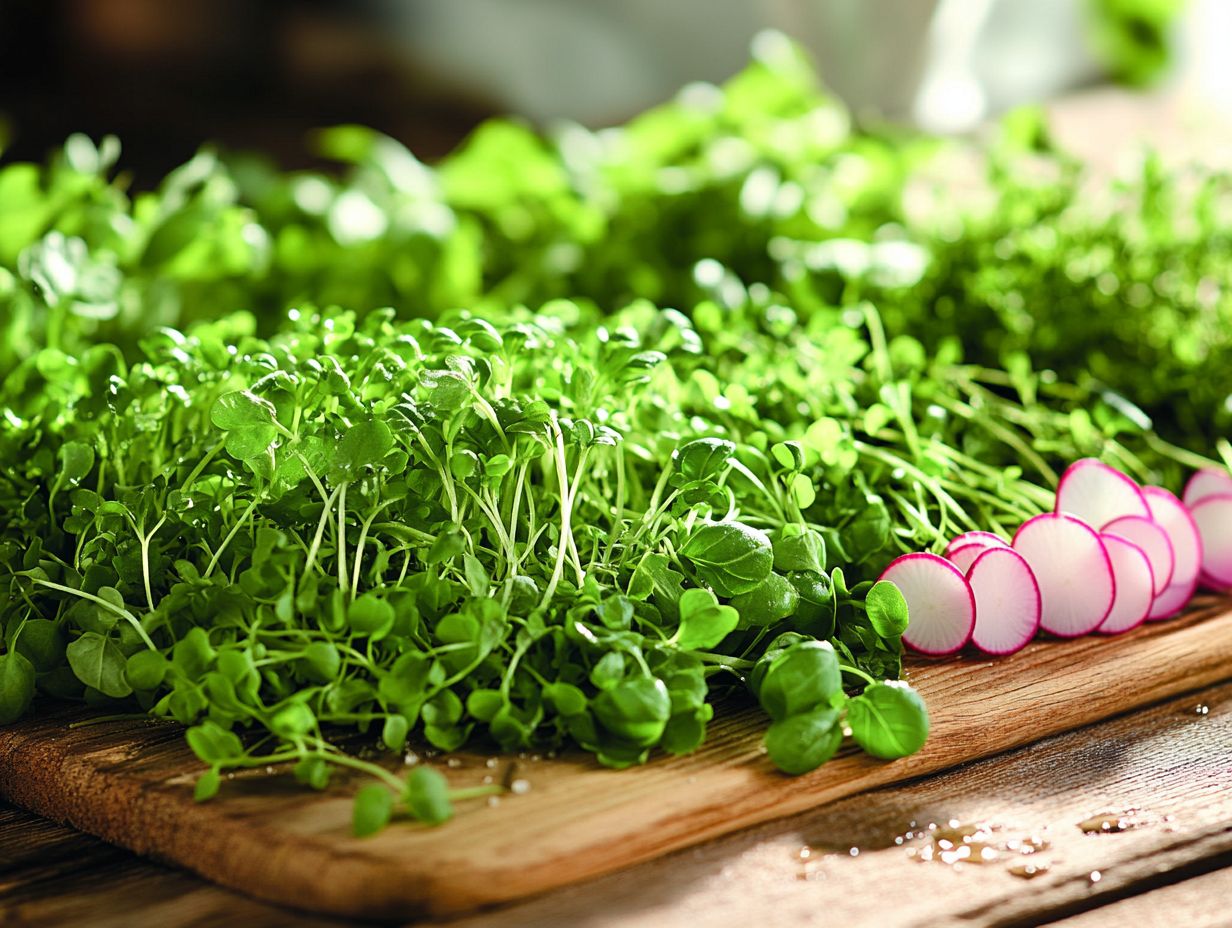
When you stack microgreens against other leafy greens, you’ll often find they have a remarkable edge in nutrients packed into a small amount. This highlights their exceptional health benefits and culinary versatility.
This impressive trait makes microgreens a valuable asset to your balanced diet. They help you boost your essential nutrient intake without needing to consume vast quantities of produce. Take varieties from the Brassica family, like broccoli and kale; they deliver concentrated doses of vitamins C, E, and K, alongside a wealth of antioxidants. To maximize your nutrition, consider incorporating the best microgreens for nutritional value. Such potent nutrient levels can support your immune function, elevate your energy levels, and promote your overall well-being.
Incorporating microgreens into your daily meals not only enhances your nutrient intake but also adds a delightful burst of flavor to salads, sandwiches, and wraps. To learn more about their advantages, check out the health benefits of microgreens explained. This transforms healthy eating into a convenient and enjoyable experience.
Growing and Harvesting Microgreens
Growing and harvesting microgreens is an elegant endeavor that anyone, whether a novice or a seasoned gardener, can embrace. This sustainable gardening option allows you to enjoy fresh, nutrient-rich greens in just a few weeks. It’s an attractive choice for enhancing your culinary creations and promoting wellness.
Step-by-Step Guide to Growing Microgreens
To successfully grow microgreens, you need to follow a few essential steps:
- Selecting the right seeds
- Preparing the growing medium
- Providing appropriate light and water
- Ensuring optimal conditions for germination
These tiny powerhouses can sprout from various seeds, especially those in the Brassica family, like broccoli and kale, which stand out for their impressive nutrient density. After you ve chosen the right seeds, the next step is to prepare a suitable growing medium. You can choose from traditional soil or exciting hydroponic options, making sure it retains moisture without turning into a soggy mess.
Once your medium is prepped, it s crucial to sow the seeds evenly. Lightly cover them to promote uniform germination. Adequate light be it natural or artificial is key to encouraging robust growth. Regular watering is also important, ensuring you avoid both drought and saturation to help sustain those tiny plants as they flourish into vibrant, nutritious microgreens.
Harvesting Techniques for Maximum Nutrient Retention
Harvesting microgreens at the optimal moment and using the right techniques is essential for maximizing their nutrient retention and ensuring food safety. This allows you to fully reap the benefits of their health-supporting properties.
Grasping the ideal time to cut these delicate plants can significantly influence their flavor profiles and health advantages. Timing is everything; if you harvest too early or too late, you risk losing vital vitamins and minerals. Utilizing methods like the clean-cut technique helps prevent contamination, which is crucial for meeting food safety standards.
By focusing on the proper approach, you not only enhance the microgreens’ taste but also preserve their vibrant colors and nutrient density. This makes them a top choice for health-conscious consumers.
Incorporating Microgreens into Your Diet
Incorporating microgreens into your diet presents a delightful and nutritious opportunity to elevate your meals. These vibrant little greens can transform a range of culinary creations. Whether you’re tossing them into salads, layering them in sandwiches, or using them as a garnish, they add a burst of flavor and visual appeal to your dishes.
Don’t miss out on adding these nutrient-packed greens to your next meal!
Embrace the vibrant world of microgreens and elevate your meals today by exploring using natural fertilizers for microgreen growth!
Ways to Enjoy Microgreens in Meals and Snacks
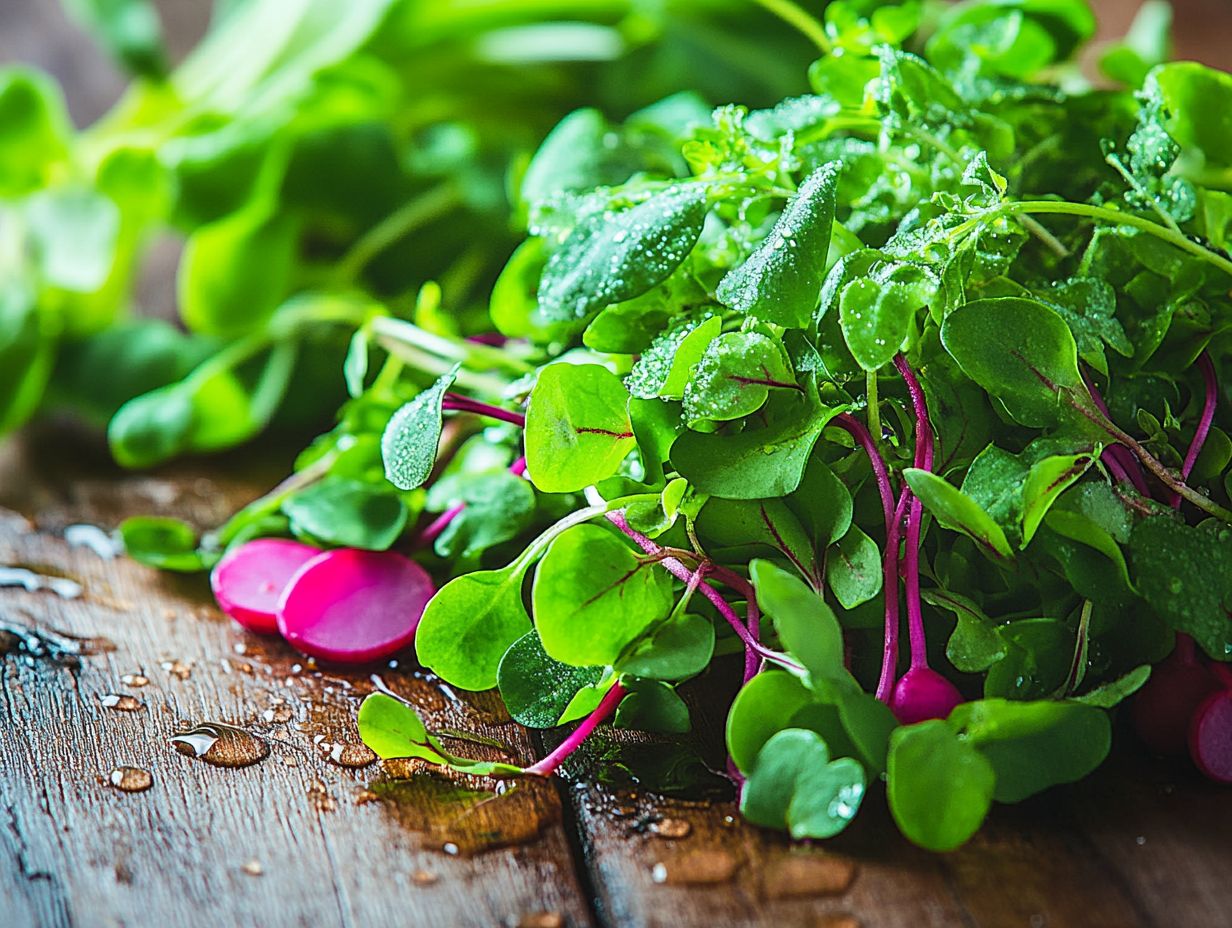
Microgreens offer a delightful array of possibilities for your cooking. You can sprinkle them atop salads for that perfect crunch. Blend them into smoothies for an invigorating nutritional boost or layer them in sandwiches to elevate flavor.
These small greens enhance the visual appeal of your dishes while providing impressive nutrient density, meaning they pack a lot of nutrients into a small amount of food. Imagine incorporating them into your morning omelet for a burst of color. Stir them into soups for a refined finishing touch or use them as an elegant garnish for your plated entrees. Additionally, discovering the benefits of eating microgreens daily can further inspire your culinary creativity.
With their rich content of vitamins and antioxidants, you can savor their fresh, distinct flavors by enjoying them raw. Consider exploring unique recipes like microgreen pesto, a tasty sauce made from microgreens, or adding them to your tacos. These tiny powerhouses offer exciting opportunities to enrich your everyday meals and are also known for their benefits, as highlighted in microgreens: the secret to healthy skin.
Potential Risks and Precautions
While microgreens present a wealth of health benefits, it’s crucial to be mindful of potential risks and necessary precautions, especially regarding food safety and the possibility of foodborne illness. By doing so, you ll enjoy a safe and delicious cooking adventure!
Food Safety and Allergen Concerns
Ensuring food safety with microgreens is all about proper handling, washing, and storage, particularly if you re concerned about foodborne illnesses or specific allergens.
To keep your microgreens fresh and safe, start by rinsing them thoroughly under cool running water. This step is vital for removing potential contaminants. Once washed, dry them gently with a clean cloth or a salad spinner. Eliminating excess moisture is key, as dampness can promote bacterial growth.
For storage, opt for airtight containers in the refrigerator to preserve the flavor and nutritional value of your greens. If you have sensitivities to certain foods, being vigilant about allergen cross-contamination is essential. Keep your microgreens separate from other ingredients and always use clean utensils.
This simple practice can significantly reduce the risk of allergenic reactions and ensure a safer culinary experience.
Cautions for Certain Populations
Certain populations, such as pregnant women, young children, and those with compromised immune systems, should approach the consumption of microgreens with caution due to potential health risks.
These groups may find themselves more susceptible to foodborne illnesses that can arise from improperly handled or contaminated microgreens. It’s wise to obtain these greens from reputable suppliers who prioritize food safety standards. Additionally, understanding the role of microgreens in healthy eating can further enhance your knowledge. Thoroughly washing microgreens before consumption is essential; this straightforward step can dramatically reduce the risk of pathogens.
If you belong to one of these at-risk categories, it s prudent to discuss your microgreen intake with a healthcare provider to evaluate the health benefits against any possible risks.
Ultimately, understanding the balance between nutrition and safety is crucial for supporting overall well-being and immune health.
Frequently Asked Questions
What are microgreens?
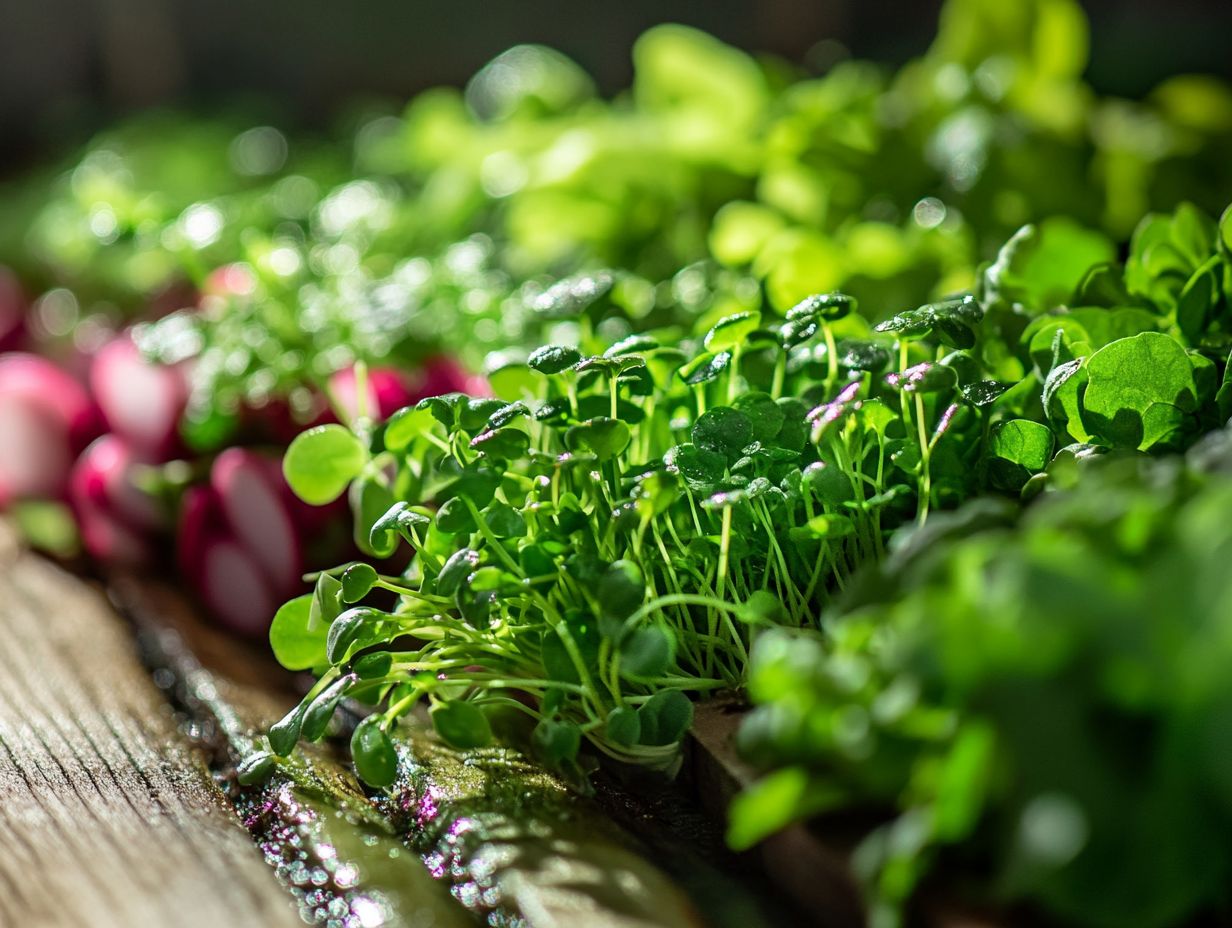
Microgreens are young, tender plants harvested just after the first leaves have developed, usually within 1-3 weeks after germination.
Why are microgreens considered a natural source of nutrients?
Microgreens are considered a natural source of nutrients because they are grown without pesticides or chemical fertilizers, making them a pure and unprocessed source of vitamins and minerals.
What types of nutrients can be found in microgreens?
Microgreens are known to contain high levels of vitamins, minerals, and antioxidants such as vitamins C and E, beta-carotene, and lutein.
How do microgreens compare to full-grown vegetables in terms of nutrition?
Studies have shown that microgreens can contain up to 40 times more nutrients than their fully grown counterparts, making them a more concentrated source of nutrition.
What are the health benefits of consuming microgreens?
Microgreens can boost your immune system and improve digestion. They also help promote healthy skin and hair!
These tiny greens may reduce swelling and protect against certain diseases. Incorporating them into your diet is a delicious way to enhance your health!
How can microgreens be incorporated into a diet?
You can add microgreens to salads, sandwiches, and smoothies. They also make a great garnish for various dishes!
Feeling creative? Use them as a herb substitute in your cooking. Their vibrant flavors will elevate any meal!

